In the ever-evolving landscape of modern bathroom design, LED mirrors, or led bathroom mirrors, have become an essential element, offering both functionality and aesthetics. A frequently asked question is: Do LED mirrors turn on with a switch? This article explores how LED mirrors function, the types of switches available, and how to choose the right one for your needs.
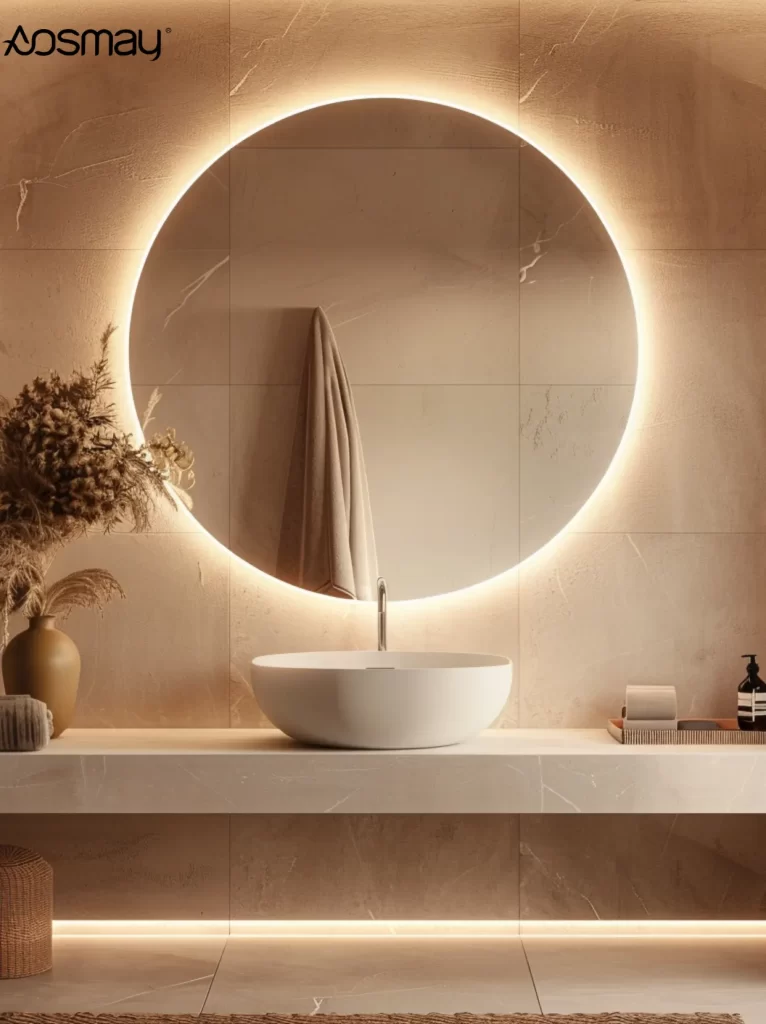
1. Understanding LED Mirrors
To answer the question, Do LED mirrors turn on with a switch? it’s important to first understand what LED mirrors are and why they’ve gained popularity. LED mirrors, also known as led bathroom mirrorss, incorporate light-emitting diodes (LEDs) that provide illumination from within or around the mirror surface. These mirrors are not just about lighting; they enhance visibility, create ambiance, and add sophistication to any bathroom. Whether for functional grooming or creating a relaxing atmosphere, LED bathroom mirrors are transformative in both residential and commercial settings, including hotels, gyms, and salons.
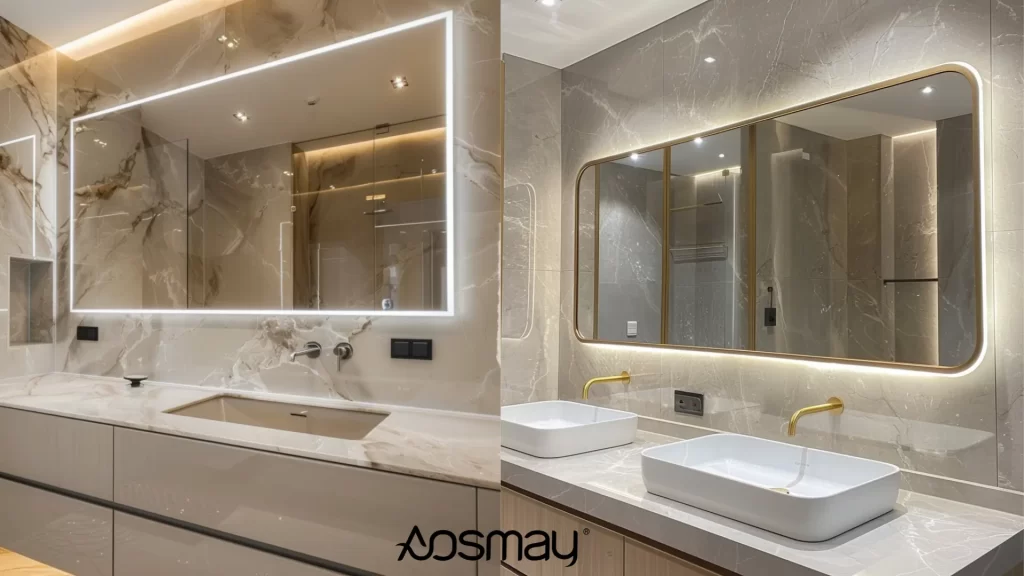
2. Do LED Mirrors Turn On with a Switch?
To answer “Do LED mirrors turn on with a switch?” it’s important to understand the different switch types available for bathroom mirror LEDs and led bathroom mirrors. Various switches, including button, touch, sensor, and remote-controlled, cater to different needs and preferences. Each type offers distinct features and benefits to enhance your experience. Let’s explore these options to help you choose the right switch for your LED mirror.
2.1. Types of Switches for LED Mirrors
To fully understand Do LED mirrors turn on with a switch?, it’s essential to examine the different switch types for bathroom LED mirrors. Here’s a closer look at the options available:
2.1.1. Touch Switches
A common and user-friendly option is the touch switch. Integrated directly into the LED mirror surface, touch switches allow users to turn the lights on or off with a simple touch. Often marked by a small illuminated icon, touch switches are easy to locate even in low-light conditions.
Touch switches not only offer a modern aesthetic, aligning with minimalist design trends in contemporary bathrooms, but also come with advanced functionalities. Many touch switches support features like adjusting brightness levels and switching between different light colors. This enhances their versatility, allowing users to customize the lighting to suit various needs, such as bright illumination for tasks or a softer glow for relaxation. The absence of external controls contributes to a clean, uncluttered space, making touch switches popular among those seeking both functionality and style.
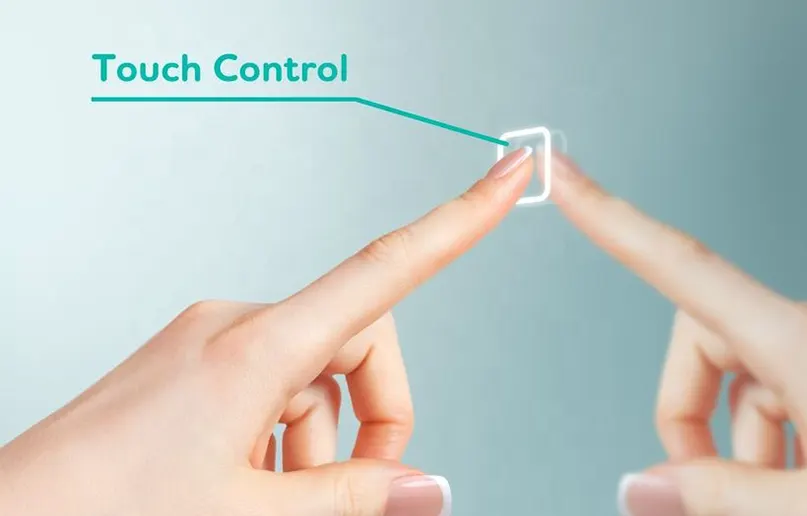
2.1.2. Sensor Switches
Another innovative option is the sensor switch. Sensor switches operate by detecting motion or proximity. For instance, an LED bathroom mirror may automatically turn on when it senses someone approaching and turn off after a period of inactivity. This type of switch is ideal for those who prefer a hands-free experience, minimizing the need to touch surfaces.
Sensor switches offer significant benefits, particularly in public places or high-traffic areas. In restrooms or hotel bathrooms, the touchless operation helps maintain hygiene by reducing contact with surfaces, which is crucial for preventing the spread of germs. Additionally, sensor switches provide a seamless and convenient experience, as users don’t need to manually operate the mirror. This enhances the overall user experience by offering a more sophisticated and sanitary solution, aligning with the high standards of modern commercial and residential settings.
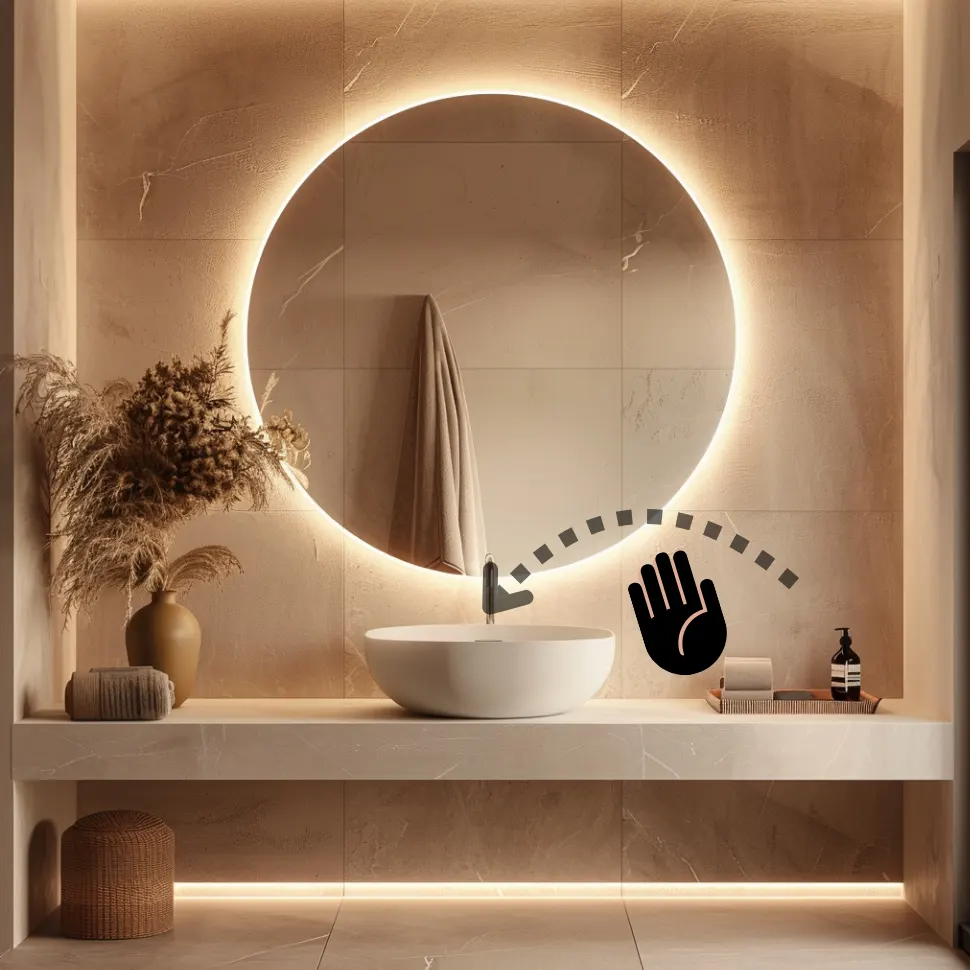
2.1.3. Button Switches
Traditional button switches remain a reliable choice for many users. Located on the side, bottom, or front of the mirror, button switches offer a tactile response that many people prefer over touch or sensor-based systems. This physical feedback makes it easier to confirm that the switch has been activated, providing a satisfying and reliable user experience.
Button switches are known for their durability, making them ideal for environments where mirrors are frequently used, such as in commercial settings like gyms, hotels, or public restrooms. They are less prone to malfunction compared to touch or sensor switches, particularly in high-traffic areas.
Additionally, button switches excel in environments with high humidity, such as bathrooms, where moisture can affect the performance of touch and sensor switches. The physical design of button switches allows them to function effectively even in such conditions, reducing maintenance concerns and extending their lifespan.
2.1.4. Remote-Controlled Switches
For ultimate convenience, some LED mirrors come with a remote control. This allows users to turn the lights on or off, adjust brightness levels, or change the light color from a distance. Remote-controlled LED bathroom mirrors are ideal for larger spaces or situations where the mirror’s location makes accessing a built-in switch difficult.
Remote controls offer flexibility, allowing users to customize their lighting experience without being near the mirror.
3. Choosing the Right Switch for Your LED Mirror
When selecting a LED bathroom mirror, the type of switch you choose can significantly impact your overall experience. Here are some factors to consider when making your decision:
3.1. Bathroom Environment
The bathroom environment is crucial in determining the most suitable switch type. In high-humidity settings, a sensor switch may be more practical than a touch switch, reducing the risk of smudges or moisture issues.
3.2. User Preferences
Some users prefer the tactile feedback of a button switch, while others may favor the modern appeal of a touch switch. It’s essential to consider who will be using the mirror and their preferences. For instance, in a family bathroom, a button switch might be more user-friendly for children, while adults may appreciate the sleek design of a touch switch.
3.3. Ease of Installation and Use
LED mirrors with built-in touch switches or sensor switches are often easier to install and use. Touch and sensor switches are integrated directly into the mirror’s design, eliminating the need for additional wiring or external controls. This streamlined installation process is advantageous for DIY projects and reduces the complexity of setup. Touch switches offer a sleek, modern look and are typically straightforward to install, as they only require basic electrical connections. Sensor switches, which operate automatically based on motion or proximity, also simplify the installation process by eliminating the need for manual activation.
On the other hand, mirrors with remote-controlled switches offer flexibility but come with a few considerations. Remote-controlled mirrors require the management of a separate remote, which can be easily misplaced. The installation might involve additional components, such as a receiver for the remote, which can add to the complexity. Ensuring the remote is always within reach and maintaining its batteries are additional tasks for users.
Each switch type has its pros and cons:
- Touch Switches: Simple installation, modern aesthetic, no external controls needed. Potential issues include sensitivity to moisture or accidental activation.
- Sensor Switches: Hands-free operation, automatic lighting, minimal physical contact. Installation is typically easy, but sensors may require calibration or adjustments.
- Remote-Controlled Switches: Flexible and customizable, allowing for adjustments from a distance. Installation can be more complex, and managing the remote is an additional responsibility.
Understanding these aspects helps you choose the switch type that best fits your installation capabilities and usage preferences.
.
4. Different Case Scenarios for Selecting LED Mirror Switches
Selecting the right switch for your LED mirror can greatly enhance its functionality depending on the environment in which it is installed. Here are some detailed case scenarios to guide you in choosing the most suitable switch type:
4.1. Home Bathroom: Comfort and Practicality Combined
In a home bathroom, especially with children or elderly family members, ease of use and safety are key. Button switches are highly practical here; their tactile feedback makes them easy to operate, even for young children or those with limited dexterity. They are also robust, handling frequent use without wear. Touch switches, on the other hand, offer a modern, sleek look that complements contemporary bathroom designs. For activities like shaving or applying makeup, touch switches provide precise control with a simple touch. Additionally, touch switches can be integrated with adjustable brightness or color temperature settings, allowing for personalized lighting for different tasks.
4.2. Luxury Hotels: Combining Luxury and Convenience
In luxury hotels, the focus is on delivering an exceptional guest experience. Sensor switches are perfect for high-end environments, offering the ultimate in convenience and a touchless operation that enhances the sophisticated feel of the bathroom. They automatically activate as guests approach, adding a high-tech touch without the need for physical contact. Remote-controlled switches add further luxury by allowing guests to customize their lighting experience from anywhere in the bathroom. They can adjust brightness, switch light colors, and even save preferred lighting settings for future use. This capability not only enhances guest comfort but also aligns with the luxury and personalized service expected in high-end accommodations.
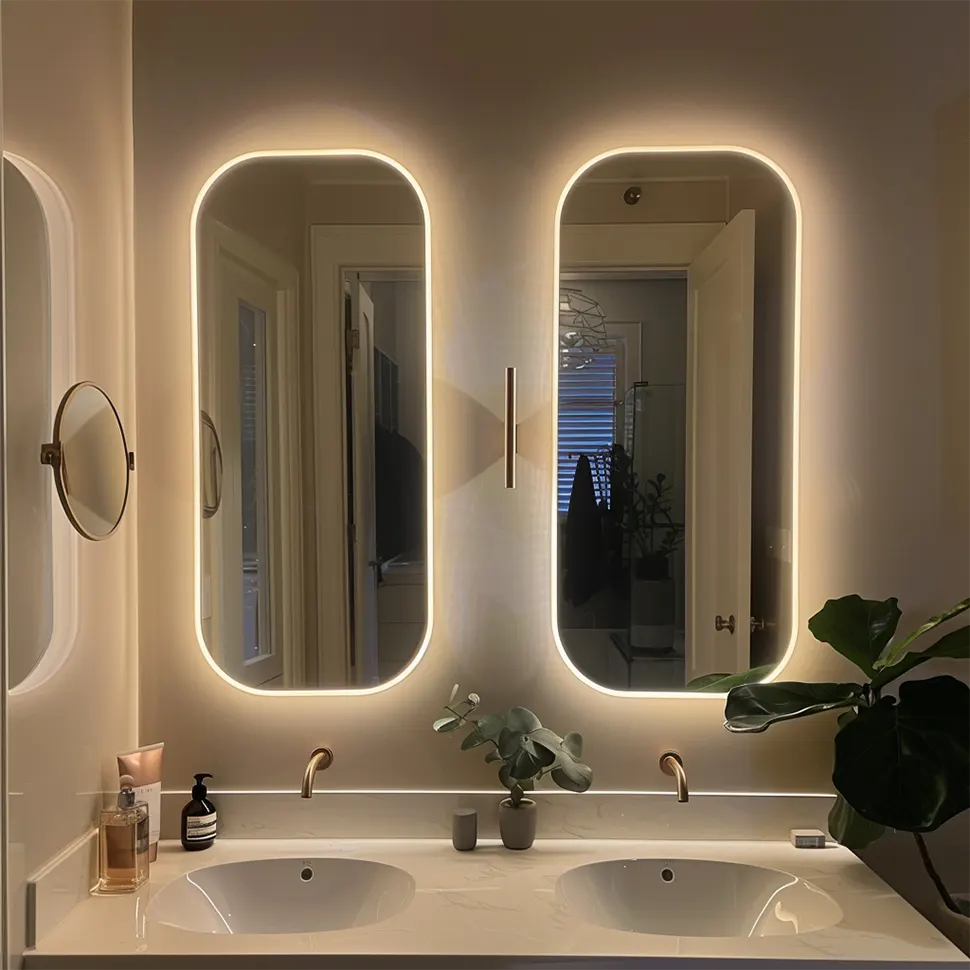
4.3. Commercial Office Buildings: Modernity and Functionality
In public restrooms or dressing rooms within commercial office buildings, touch switches and sensor switches are both suitable options. Touch switches offer a sleek, modern look that fits well with the contemporary design of commercial spaces. They provide a simple and direct interface for users. Sensor switches are ideal for high-traffic areas where ease of use and hygiene are paramount. They eliminate the need for physical contact, which helps maintain cleanliness and minimizes the spread of germs. Sensor switches also ensure that lights are always on when needed, enhancing the overall functionality and efficiency of these high-usage areas.
4.4. Beauty Salons: Multifunctionality and Customization
In beauty salons, where lighting is crucial for various services, remote-controlled switches are highly advantageous. They allow staff to adjust the LED mirror lighting to meet different service needs, such as enhancing visibility for precise makeup application or creating a relaxed ambiance for facials. With a remote control, staff can easily change the brightness and color temperature to suit each client’s preferences, improving the quality of service and overall client satisfaction. Sensor switches are also beneficial in salons, providing touchless operation that helps maintain a clean and hygienic environment, which is essential in high-touch service settings.
Through these expanded scenarios, users can better understand which switch type best fits their specific environment and needs, allowing for a more informed and effective choice.
5. Common Issues with LED Mirror Switches and Troubleshooting
While LED mirrors are generally reliable, issues with switches can occasionally arise. Here are some common problems, their potential solutions, and tips for preventing future issues:
5.1. Touch Switch Not Responding
- Issue: The touch switch may not respond due to dirt, moisture, or a wiring issue.
- Solution: Clean the mirror’s surface thoroughly with a soft, dry cloth to remove any dirt or moisture that might be interfering with the touch sensor. If cleaning doesn’t resolve the issue, inspect the wiring connections and consult a professional if needed.
- Prevention: Regularly clean the mirror surface to avoid buildup of dust or moisture. Avoid using abrasive cleaners that could damage the touch-sensitive layer.
5.2. Sensor Switch Not Detecting Motion
- Issue: The sensor switch may not detect motion if obstructed by dirt or debris, or if the sensitivity settings are incorrect.
- Solution: Check and clean the sensor area to ensure it is free from obstructions. If cleaning doesn’t help, adjust the sensitivity settings or inspect the power supply.
- Prevention: Periodically check the sensor for any obstructions or dust buildup. Keep the area around the sensor clean and unobstructed to maintain proper functionality.
5.3. Button Switch Sticking
- Issue: Button switches can become sticky due to accumulated dirt or moisture, or they may be damaged.
- Solution: Clean the button regularly with a damp cloth and ensure it is fully dry before use. For sticky buttons, occasional lubrication with a suitable product can help. If the button is physically damaged, replacement may be necessary.
- Prevention: Regularly clean around the button area to prevent dirt accumulation. Consider using a protective cover if the environment is particularly dusty or humid.
5.4. Remote Control Not Working
- Issue: The remote may not work due to dead batteries, interference, or issues with the receiver.
- Solution: Replace the batteries in the remote and ensure there is a clear line of sight between the remote and the mirror. If problems persist, check the remote and the mirror’s receiver for potential faults that may require professional repair.
- Prevention: Regularly check and replace remote control batteries to ensure optimal performance. Store the remote in a designated spot to avoid losing it and ensure it is not exposed to extreme conditions.
6. Conclusion
In conclusion, Do LED mirrors turn on with a switch? Yes, they do. The type of switch you choose can greatly affect your experience. Whether you prefer the simplicity of a button switch, the modern touch of a sensor switch, or the convenience of a remote control, there’s an LED mirror that meets your needs. When choosing an LED mirror switch, consider factors like bathroom environment, user preferences, and ease of installation. Selecting the right switch enhances both the functionality and aesthetics of your LED mirror, providing practical illumination and style.
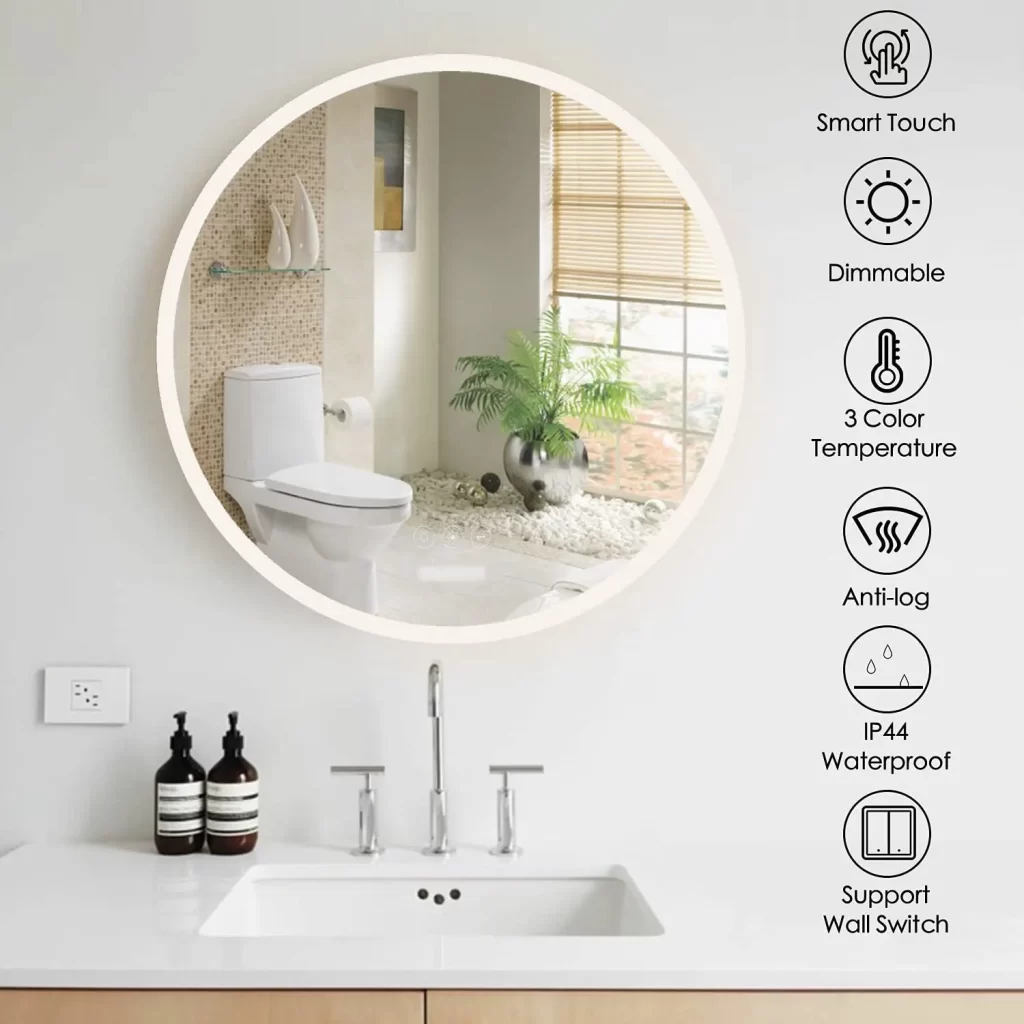
7. Frequently Asked Questions (FAQ)
7.1. How do LED mirrors turn on, and what switch options are available?
LED mirrors typically feature various switch types to control the lighting, including:
- Touch Switches:Allow you to control the mirror’s lighting with a simple touch, often integrating a sleek, modern design.
- Sensor Switches:Activate the lights automatically when motion is detected, ideal for a hands-free experience.
- Button Switches:Provide a tactile response and are durable, making them suitable for high-traffic or commercial settings.
- Remote-Controlled Switches:Enable you to adjust settings like brightness and light color from a distance, adding convenience and flexibility.
7.2. What is the best switch type for different environments?
- Home Bathrooms:Touch or button switches are ideal for their ease of use and reliability.
- Luxury Hotels:Sensor and remote-controlled switches offer a sophisticated, convenient experience.
- Commercial Spaces:Touch or sensor switches suit high-traffic areas with a modern touch.
- Beauty Salons:Remote-controlled and sensor switches provide customization and cleanliness.
7.3. Can LED mirrors be operated with multiple switches?
Yes, some LED mirrors can use multiple switch types, like touch and remote controls, for added convenience.
7.4. Are there LED mirrors with customizable switch settings?
Yes, some LED mirrors allow customization of brightness, light color, and switch types.